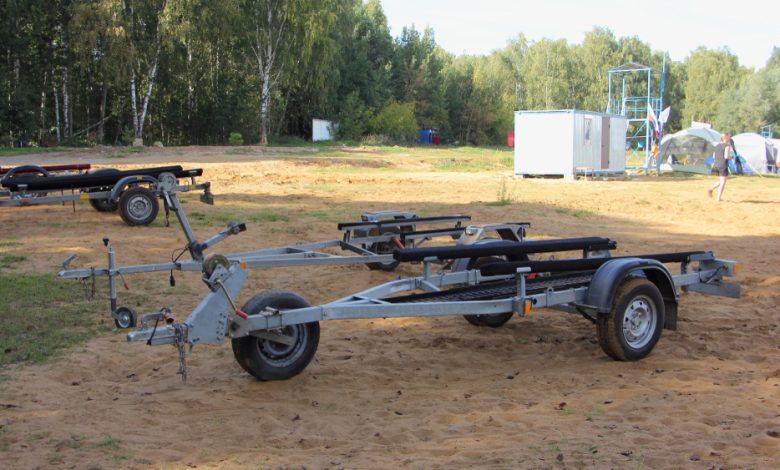6 Things to Remember When Hitching A Single Axle Trailer

Many boat owners prefer a boat trailer to safely and efficiently transport their boats. Whether they’re headed to a new fishing spot or a new county, a trailer will always keep a boat in tip-top shape, ready to hit the water. One of the most common types of trailers used to haul various types of boats is a single axle trailer. Let’s find more about this type of trailer and how to efficiently use this on your next trip in this single axle trailer guide.
What is a Single Axle Trailer?
A single axle trailer is a type of trailer with one axle and a wheel connected on every end. This type of trailer is connected to a trailer using springs. It may be connected to the trailer bed using special hardware or clamps.
Boat owners prefer a single axle trailer to other types of trailers because of the following features:
- This is ideal for towing lighter boats in short distances.
- This type of trailer is lightweight and thus uses less fuel to drag around.
- Cheaper, more economical to purchase.
- Single axle trailers are easier to park, even in tight parking spots.
- This trailer is easier to move around than double axles of the same size.
- This is much easier to maintain because it has fewer tires, brakes, and bearings.
Like other boat trailers, single axle trailers also come with some disadvantages. Here are some you might be familiar with:
- This type of trailer can’t handle a heavy load as a tandem axle trailer of the same size.
- Most single axle trailers below 750kg GTM don’t need brakes. This is an important safety factor to consider.
- This trailer is harder on the tires as these can take heavier loads.
- In the case of a flat tire, the trailer will wobble because you only have two wheels.
- There’s no suspension, so there’s no cushion to your load.
How To Properly Use a Single Axle Trailer
As a full-pledge boat owner, you need to learn how to properly use a boat trailer. Here are some essential things to remember:
Check Local Towing Laws
Before towing your boat, you must know and understand local laws and rules about trailers. The state determines private use of boat trailers, so expect differences in these laws. The best place to check is from the department of transportation of your state.
Know About GCWR
GCWR is short for Gross Combined Weight Rating. This is the weight of the towing vehicle, passengers, cargo, trailer, and load. The value is determined by the truck or the car manufacturer as the maximum weight that a vehicle can safely tow. Do not exceed the given GCWR.
- SUVs and 4-wheel drive trucks can reduce towing capacity. As much as possible, use a rear-wheel drive for the most efficient towing.
- SUVs and trucks with a longer wheelbase can easily tow more than vehicles with a shorter body. These vehicles offer better control even when hooked with a trailer.
- Diesel trucks have higher towing ratings compared to gasoline trucks.
- SUVs and many trucks have a variety of axle ratios. A vehicle with a higher ratio has enhanced pulling power but may consume more fuel.
Select the Right Trailer
Using the right type of trailer can give you more towing power and enhanced features. A single-axle trailer is the best choice if you’re towing light loads such as small boats. When hauling cars, ATVs, or any kind of cargo, a flat-floor trailer is best. Meanwhile, there are double-axle trailers if you wish to tow larger, heavier loads and boats.
About Hitches and Balls
There are many kinds of conventional hitches. These are according to the amount of weight or cargo.
- Class 1 Hitches – can haul up to 2,000 pounds of weight
- Class 2 Hitches – can carry up to 2,000 pounds of weight
- Class 3 Hitches – can take up to 8,000 pounds of weight
- Class 4 Hitches – can haul up to 10,000 pounds of weight
- Class 5 Hitches – can accommodate weights up to 12.000 pounds
Cars and crossover vehicles have Class 1, 2, or 3 hitches. SUVs and large trucks come with Class 3, 4, and 5 hitches. Every type of hitch comes with a specific size of the receiver tube. From this tube, the ball and the ball mount are attached.
- Class 1 and 2 Hitches – these come with a 1.25-inch receiver tube
- Class 3 Hitches – with a 2-inch receiver tube
- Class 4 and 5 Hitches – with a 2 to 2.5-inch receiver tube. This may depend on the vehicle configuration
Remember that the trailer must always sit level from the front to the back. Sometimes boaters use ball mounts to raise or lower the ball if necessary.
The size of the ball depends on the trailer weight. You’ll find the ball size from the coupler. And in case you need to haul more than 12,000 pounds, use a heavy-duty vehicle or truck. The car must have a fifth-wheel or gooseneck hitch. A gooseneck ball-type setup can accommodate up to 30,000 pounds of weight. Meanwhile, fifth wheelers use a horseshoe shape mount which can take up to 25,000 pounds.
Hooking The Trailer
To hook your trailer to your vehicle, you must carefully follow these steps. We recommend creating a checklist to ensure everything’s safe and correctly installed.
- Place the ball mount in your hitch receiver tube.
- Place the vehicle in front of the coupler for the trailer.
- The coupler must be placed higher than the ball of the hitch.
- Drive and back up slowly to keep the ball under the coupler. You may need a spotter to make sure everything is done correctly.
- Place your vehicle in the park and apply the parking brake.
- From the trailer tongue, locate a twist handle to raise or lower the jack. This is a bar or metal pipe where the trailer rests when not connected to a truck.
- Secure the coupler on the ball using the cotter pin attached to the part.
- Raise the tongue to check if everything is in place.
- Raise the jack of the trailer and remove this altogether.
Loading Your Boat
A friend must keep the boat in position as you maneuver the tow vehicle. Discover Boating recommends these steps.
- Idle up to the ramp dock. Place the boat in the correct position.
- The tow vehicle must be on Park with the parking brake engaged.
- Back the trailer in the water in a straight line. Go into the water at a depth that allows the boat to move over the trailer bunks.
- Idle the boat on the bunks. Keep the bow peak and the trailer bow stops aligned.
- Clip the winch strap on the bow eye. The winch can pull the boat so that it’s snug safe on the winch post. Secure this using a safety chain.
Final Words
When hitching a single axle trailer to your tow vehicle, always consider local towing laws and the GWCR for safe and efficient towing. It may take time to learn how to hitch a trailer to your car and load your craft. Nevertheless, connecting and loading a trailer is a practical skill that every boat owner should learn and perfect.





